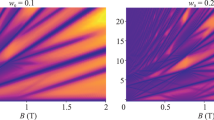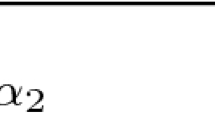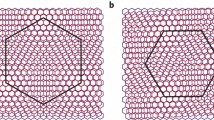Abstract
The graphene-hexagonal boron nitride (G-hBN) plays a role of quantum dynamical systems under the influence of external fields. Quantum chaos theory concerning level repulsion can provide a clear picture of the influence of the structural factors such as impurity, number of atoms, and distance between the layers and environmental factors such as the external electric fields on the current-voltage variation. The association schemes theory in the perspective of the cycle graph is introduced to establish a relationship between the atoms in graphene and the hBN lattice. By using Bose–Mesner algebra, we have obtained an analytical method to study the conductivity in the G-hBN. We have recognized the insulator-metal transition in G-hBN by synchronously changing the Brody distribution from Poisson to Wigner distribution. We have considered the lattice with \(N_T(G/hBN)=50 \times 100\) atoms to study the impact of the impurity types on conductivity. Increasing the voltage in the G-hBN results in a negative differential resistance in the current-voltage diagram. We have observed that choosing the voltage from the NDR region results in the appearance of Wigner distribution in the level of energy spectrums. The Wigner distribution is essentially a measure for detecting the presence of quantum chaos. The study reports the threshold value of the transverse electric fields, and sufficiently (silicon/carbon) doping for generating the electrical current in the \(\mu \; A\) range. The obtained results indicate that carbon atoms, by low concentration, are acted better than silicon in this transition.








Similar content being viewed by others
References
K.S. Novoselova, K. Geims, V. Morozovd, D. Jiangy, Y. Zhang, V. Dubonosi, V. Grigorieva, A.A. Firsov, Science 306, 666–669 (2004)
L. Likai, K. Jonghwan, J. Chenhao, Y.G. Jun, D.Y. Qiu, H. Felipe, Z. Shi, L. Chen, Z. Zhang, F. Yang et al., Nat. Nanotechnol. 12, 12–25 (2017)
K.K. Kang, L.H. Seok, L.Y. Hee, Chem. Soc. Rev. 47, 6342–6369 (2018)
U. Teerayut, T. Takashi, W. Kenji, N. Kosuke, ACS Appl. Mater. Interfaces 10, 28780–28788 (2018)
X. Luo, Z. Cheng, Z. Liu, L. Xu, X. Zhai, W. Wan, Y. Zhou, J. Phys. D Appl. Phys. 54(37), 375303 (2021)
N.F. Yuan, L. Fu, Phys. Rev. B 87, 121401 (2018)
A.O. Sboychakov, A.L. Rakhmanov, A.V. Rozhkov, F. Nori, Phys. Rev. B 87, 121401 (2013)
A. Allain, Zh. Han, V. Bouchiat, Nat. Mater. 11, 590 (2012)
A. Mishchenko, Tu. Js, Y. Cao, R.V. Gorbachev, J.R. Wallbank, M.T. Greenaway, V.E. Morozov, S.V. Morozov, M.J. Zhu, S.L. Wong et al., Nat. Nanotechnol. 9, 808–813 (2014)
D.J. Leech, J.J.P. Thompson, M. Mucha-Kruczyński, Phys. Rev. Appl. 10, 034014 (2018)
D. Coello-Fiallos, T. Tene, J.L. Guayllas, D. Haro, A. Haro, C.V. Gomez, Materials Today: Proceedings 4, 6835–6841 (2017)
J. Jung, A.H. MacDonald, Phys. Rev. B 89, 035405 (2014)
A.V. Rozhkov, A.O. Sboychakov, A.L. Rakhmanov, F. Nori, Phys. Rep. 648, 1–104 (2016)
G. Casati, Chaotic behavior in quantum systems: theory and applications (Springer, New York, 2012)
H. Stöckmann, Quantum chaos: an introduction, (American Association of Physics Teachers, 2000)
Y. Liao, A. Vikram, V. Galitski, Phys. Rev. Lett. 125, 250601 (2020)
Y.Y. Zhang, J. Hu, B.A. Bernevig, X.R. Wang, X.C. Xie, W.M. Liu, Phys. Rev. Lett. 102, 106401 (2009)
A. Rycerz, Phys. Rev. B 85, 245424 (2012)
K.B. Efetov, Adv. Phys. 32, 53–127 (1983)
S. Behnia, F. Rahimi, Phys. Lett. A 382, 3274–3280 (2018)
R. Bose, Pac. J. Math. 13, 389–419 (1963)
RCh. Bose, D.M. Mesner, Annal. Math. Stat. 30, 21–38 (1959)
J.L. Gross, J. Yellen, Handbook of graph theory (CRC Press, USA, 2004)
R.A. Bailey, Association schemes: designed experiments, algebra and combinatorics (Cambridge University Press, Cambridge, 2004)
M.A. Jafarizadeh, S. Behnia, E. Faizi, S. Ahadpour, Pramana 70, 417–438 (2008)
E. Bannai, T. Ito, Algebraic combinatorics (Benjamin/Cummings Menlo Park, 1984)
M.A. Jafarizadeh, R. Sufiani, S. Jafarizadeh, J. Math. Phys. 49, 073303 (2008)
J.E. Humphreys, Introduction to Lie algebras and representation theory (Springer, New York, 2012)
F. Joucken, Y. Tison, J. Lagoute, J. Dumont, D. Cabosart, B. Zheng, V. Repain, C. Chacon, Y. Girard, A.R. Botello-Méndez et al., Phys. Rev. B 85, 161408 (2012)
J.-Ch. Charlier, X. Blase, S. Roche, Rev. Modern Phys. 79, 677 (2007)
J. Jung, A.H. MacDonald, Phys. Rev. B 81, 195408 (2010)
T. Van-Truong, Université Paris Saclay NNT : 2015SACLS133 (2015)
F. Haake, Quantum signature of chaos (Springer, New York, 2009)
O. Bohigas, M.J. Giannoni, Ch. Schmit, Phys. Rev. Lett. 52, 1 (1984)
S. Behnia, F. Rahimi, J. Phys. Soc. Jpn. 87, 114602 (2018)
C. Leon, M. Costa, L. Chico, A. Latgé, Scientific Rep. 9, 1–11 (2019)
C. Maddi, F. Bourquard, V. Barnier, J. Avila, M.C. Asensio, T. Tite, F. Garrelie, Scientific Rep. 8, 1–13 (2018)
H. Kökten, S. Erkoç, Physica E Low-dimen Syst Nanostruct 44, 215–217 (2011)
T.A. Brody, Lettere al Nuovo Cimento (1971-1985) 7, 482–484 (1973)
F. Guinea, N.R. Walet, Phys. Rev. B 99, 205134 (2019)
F. Evers, A.D. Mirlin, Rev. Mod. Phys. 80, 1355 (2008)
N.C. Murphy, R. Wortis, W.A. Atkinson, Phys. Rev. B 83, 184206 (2011)
A.A. Elkamshishy, C.H. Greene, Phys. Rev. E 103, 062211 (2021)
M. Yahyavi, B. Hetényi, B. Tanatar, Phys. Rev. B 100, 064202 (2019)
S. Behnia, S. Fathizadeh, Phys. Rev. E 91, 022719 (2015)
S. Awasthi, P.S. Gopinathan, A. Rajanikanth, C. Bansal, J. Sci. Adv. Mater. Dev. 3, 37–43 (2018)
M.T. Greenaway, E.E. Vdovin, D. Ghazaryan, A. Misra, A. Mishchenko, Y. Cao, Z. Wang, J.R. Wallbank, M. Holwill, Y.N. Khanin et al., Commun. Phys. 1, 1–7 (2018)
W. Ortiz, N.J. Ramirez, D. Barrionuevo, M.K. Bhattarai, P. Feng, Nano Express 2, 010020 (2021)
M.S. Azzaz, C. Tanougast, S. Sadoudi, R. Fellah, A.A. Dandache, Commun. Nonlinear Sci. Numer. Simul. 18, 1792–1804 (2013)
M. Wang, Ch.M. Li, Phys. Chem. Chem. Phys. 13, 1413–1418 (2011)
X.K. Chen, J. Liu, Zh.H. Peng, D. Du, K.Q. Chen, Appl. Phys. Lett. 110, 0919107 (2017)
Y. Zhao, Z. Wan, U. Hetmanuik, M.P. Anantram, IEEE Electron Dev. Lett. 37, 1242–1245 (2016)
P. Boriskov, A. Velichko, Electronics 8, 922 (2019)
H. Ma, W. Wang, H. Xu, Zh. Wang, Y. Tao, P. Chen, W. Liu, X. Zhang, J. Ma, Y. Liu, ACS Appl. Mater. Interfaces 10, 21755–21763 (2018)
O. Okikiola, M. Lyudmila, M. Rabi’atu, I. Emmanuel, B. Abdulhakee, FlatChem 24, 100194 (2020)
S.K. Haldar, B. Chakrabarti, N.D. Chavda, T.K. Das, S. Canuto, V.K.B. Kota, Phys. Rev. A 89, 043607 (2014)
S. Schierenberg, F. Bruckmann, T. Wettig, Phys. Rev. E 85, 061130 (2012)
A.G. Magner, A.I. Levon, S.V. Radionov, Eur. Phys. J. A 54, 1–6 (2018)
B. Batistić, C. Lozej, M. Robnik, Phys. Rev. E 100, 062208 (2019)
Author information
Authors and Affiliations
Corresponding author
Ethics declarations
Data Availability Statement
All needed data are contained in the paper.
Funding
No funding was received to assist with the preparation of this manuscript.
Appendices
A Spectral fluctuations
The most direct manifestation of the level fluctuations in the study of short-range spectral correlations is the nearest-neighbor spacing distribution P(s), which measures local short-range correlations of eigenvalues [56]. It allows us to compare the statistical properties of different parts of the spectrum. The spacings \(s_{i}=E_{i+1}-E_{i}\) are determined from the unfolded spectrum. To obtain the unfolded level spacing distribution, rescaling the energies levels to get the unitary mean level density, we cut \(10\%\) of the energy in both ends of the spectrum. By fitting the level counting function with a seven-order polynomial, we can obtain the unfolded spectrum. After transforming all eigenvalues, their spectral density is uniform. A stable state with non-interacting levels exhibits Poissonian nearest-neighbor spacing distribution (NNSD) \((P(s)=e^{-s})\) with a peak at \(s = 0\) indicating level clustering [57]. Also, in the unstable mode, a system with linear level repulsion at \(s \rightarrow 0\) is described through the Wigner–Dyson NNSD \((P(s)=\frac{\pi }{2}se^{-\frac{\pi }{4}s^2})\) [58]. In some conditions, P(s) has an interesting behavior that is not completely Poisson nor Wigner. There are other distributions for characterizing such a behavior. The most popular are Brody distribution, where \(\beta \) is the “repulsion parameter” that characterizes the degree of repulsion of the energy levels [39].
where \( \alpha = \left( \varGamma \left[ \dfrac{\beta +2}{\beta +1}\right] \right) ^{\beta +1}\), and \(\beta \) is the Brody parameter. In the limit of \(\beta =0\) the distribution is Poissonian (localized systems), and it is proportional to \(e^{-s}\). For delocalized systems (\(\beta =1\)) the distribution is well described by Wigner distribution, and it is proportional to \(e^{-\pi s^2/4}\) [59].
B Mean inverse participation ratio
Mean inverse participation ratio [35] is a measure for the degree of localization and is defined as:
where \(\Psi _i(x)\) is an eigenvector of Hamiltonian and correspond to the site i with energy \( E_n \). MIPR, as a phase transition indicator, helps to distinguish critical extended phases. It is an effective tool to distinguish the extended regions from localized states, where only a finite number of sites are occupied. It tends to be zero in thermodynamics limit, and \(\frac{1}{L}\) in the extended state.
Rights and permissions
About this article
Cite this article
Behnia, S., Nemati, F. & Yagoubi-Notash, M. Structural stability of electrical current in graphene-hexagonal boron nitride heterostructures: a quantum chaos approach. Eur. Phys. J. Plus 137, 347 (2022). https://doi.org/10.1140/epjp/s13360-022-02559-0
Received:
Accepted:
Published:
DOI: https://doi.org/10.1140/epjp/s13360-022-02559-0




